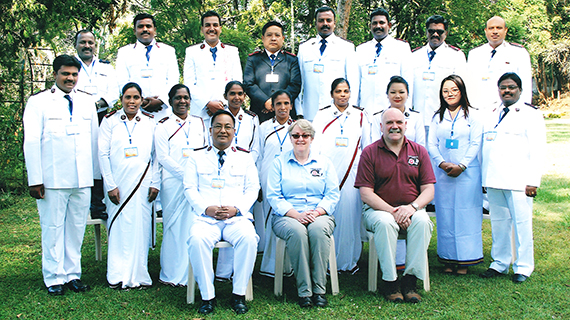
Different types of Natural and Man-made disasters have been happening very often in different parts of India. The Salvation Army, which happened to be within the affected areas, would do its best to help those in need. The Corps, Division and Territories has always done their best in meeting the needs of the effected community in accordance to the humanitarian charter, and has done fairly well. But, it has always been felt that there is the need for more professionals and trained people with whose efforts the results would be more effective in responding to emergency disasters.
It is the desire of the Social & Emergency Department of the India National Secretariat Office to train more people from the different parts of India so that the Army's efforts would be more arranged and professional in the way we deal with disasters. The vision and desires to conduct such a training finally became a reality when the International Headquarters approved and responded to the proposals. When and after Majors Alison Thompson, International Emergency Services Coordinator and Drew Ruthven, SAID Engagement Coordinator, Melbourne displays their professionalism and rich experiences, the 17 delegates from the six Indian Territories realised that they have been trained by the best international faculties. The course covered the different spheres of Emergency Responses from within and outside of the Sphere Handbook, it may be briefed as:
1. The Salvation Army role in Relief; Hazards and Disasters
2. Sphere Project 1: Humanitarian Charter;
3. Sphere Project 2: Code of Conduct;
4. Sphere Project 3: Minimum Standard and Core Humanitarian Standards
5. Needs assessment; Coordination; Protection of Beneficiaries; Child Protection; Incident Command System
6. Disaster Risk Reduction; Accountability and Transparency and case study preparation
Practical lessons and PowerPoint, supported by videos added flavour to the joy of learning. Learning skills of collecting information to understand the disaster situation through the project cycle; such as Disaster – Assessment – Analyse – Plan/redesign – Implement – Monitor/ evaluate and then continue cycle from evaluate to fresh analyse.
a. Learning how to judge the assessment reports through notable quotes to get right information;
b. How to coordinate with the international and national agencies (through the ball games);
c. The importance of being accountable to donors/headquarters, NGOs /Groups and to the beneficiaries by the application of the 9 Accountability Principles;
d. Child Protection concerns during humanitarian crises – applying the Minimum Standards for Child Protection in Humanitarian Action (CPMS) and by applying the Salvation Army Child Protection Policy.
e. Applying of Disaster Risk Reduction (DRR) policy through the disaster management cycle: Disaster/Impact – Relief – Recovery – Mitigation/Prevention – Disaster Risk Reduction – Preparedness.
I thank God, the International leaders, the skilled faculties and the National Secretary for making the desire and dream of conducting the All India “PREPARE” Emergency Disaster Training become a reality in which a combination of seventeen officers and non-officers has been freshly trained to face disasters as professionals.
Reported by Major Vanlaltluanga Pachuau, Secretary for Social & Emergency Contact Person forn Anti-Human Trafficking in India





